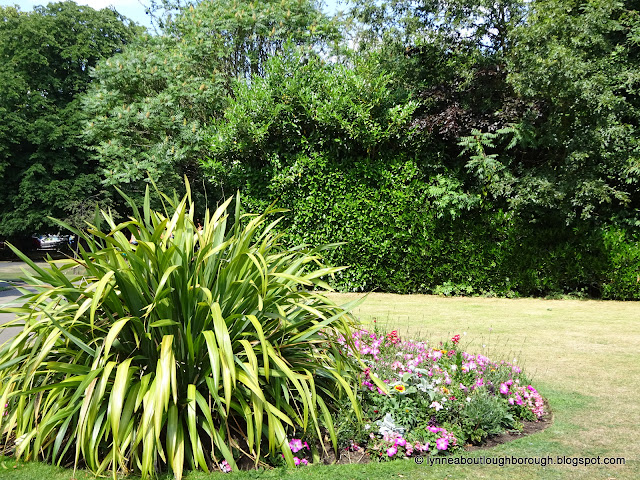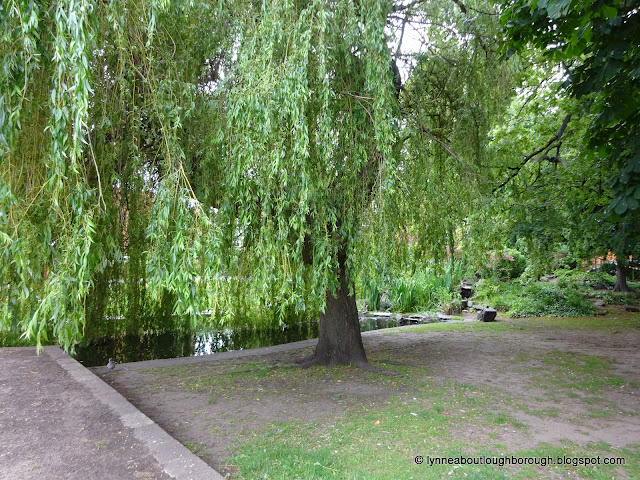What follows is the tying up of another loose end I
promised in relation to Ernest Edwin Coltman, and it is indeed a relation we
are considering! Ernest Edwin Coltman had a nephew, well, actually he had more
than one nephew, and nieces too, but it is one specific nephew who is the subject
of this post.
Possibly named after his uncle, and very likely to have
been named after his grandfather, Ernest Huram Marsh was born on 18 July 1892
at Tempé House in Swepstone. Swepstone was a small parish in North-West Leicestershire,
which had been in existence since before the Domesday Book of 1086. Ernest’s
parents, who had married in 1882, were John William Marsh, a farmer who had
been born at Woodthorpe around 1855, and Eliza Ann, Ernest Edwin Coltman’s
older sister.
 |
| Woodthorpe in July 2023 |
Ernest Huram’s older sister Frances Ethel Marsh had been
born in 1885, and Mabel Eliza Marsh in 1888. In 1891 the family were living at
a farm in Swepstone, and had a nursery governess, Lucy Hill, a general domestic
servant, Julia Cooper, and Edward Basford was the farm hand. In 1901 When Ernest
Huram Marsh was aged 8, the family were still in Swepstone, but now only had
one servant, Emily Wood. In 1902, another son was born – John Bernard Sidney
Marsh, however, by 1911 the family had moved to Forest Road, Loughborough, next door to a house called Forest Hey. Father
John was now a corncake merchant, living with his wife, Eliza, two daughters
Frances and Mabel, and son John.
 |
| Forest Hey looking away from town |
 |
| Forest Hey looking towards town |
Ernest Huram attended the Loughborough Intermediate School, before going on to the Loughborough Grammar School, where he seemed to excel at sport, gaining the Kaye Cup for athletics in both 1908 and 1909. He was also Captain of the First XI football, a member of the First XI Cricket, and of the Tennis VI. Oh, and he also had the nickname of 'Emma', whilst at LGS, a name which he still rejoiced in, throughout his life.
 |
| Loughborough Grammar School in 2021 |
Ernest Huram, in 1911, was now nearly 17, and had been
engaged in an apprenticeship for two years, since 1909. This apprenticeship had
followed a period of general education at the Loughborough Intermediate School,
which he attended from 1901-1906, before moving on to the Loughborough Grammar
School from 1906-1909, where he had passed the Senior Oxford Examination. His younger brother, John Bernard Sidney Marsh (known I believe as Bernard) would also attend the LGS.
Ernest Huram undertook his technical education at the
Grantham Technical Institute from 1909-1910, where he studied second stage Practical
Maths; gained a second class in Machine Drawing, and in first stage Applied
Mechanics. In each of his first stage Applied Mechanics, Construction, and Heat
Engines studies he gained a first class.
 |
| In 1897 the Grantham Technical Institute moved into this building, the former guildhall and jail. Whether or not it was still the Institute when Ernest arrived, I'm not sure. |
At the age of 16 ½, Ernest Huram began an apprenticeship
with Hornsby’s, in the gas-engine fitting and erecting workshops. In December
1910, at the age of 18, Ernest Huram March applied for membership of the Institute
of Mechanical Engineers. He was an engineering pupil, working for Messrs.
Richard Hornsby and Sons, Ltd, at Spittlegate Iron Works in Grantham, where he
was an apprentice. The iron works were adjacent to the LNER as it passed through Grantham.
Richard Hornsby, snr., had taken over the well-established
firm (makers of ploughs and seed drills) in 1828, and the company had thrived,
winning a council medal at the Great Exhibition in 1851 at Crystal Palace for
their products – a corn and seed drill, drop drill, two-row turnip drill on the
ridge, oil-cake bruiser and steam engine – reminds me of Robert Bakewell! By 1861, the firm were employing 378 men, and when Richard Hornsby
snr. died in 1864, the firm was carried on by his son, Richard, who led the
company to more prize-winning products. After its becoming a limited company in
1879, more prizes followed, so by the time Ernest Huram joined, the firm it was
thriving.
His application to the Institute of Mechanical Engineers was
proposed by Charles H. Gadsby, a member of the Institution, who was based in
London and was his uncle by marriage, having wed Florence Mary Coltman in 1886.
The proposal was supported by another member of the Institution, this time,
John Charles Coltman, another uncle, based in Loughborough. Further supporters
of the proposal were members David Roberts, and Charles James. I believe the
proposal was accepted and Ernest Huram Marsh joined the Institute as an
associate.
So, while his family is living on Forest Road, in 1911, Ernest Huram is boarding with the Bowler family
at 20 St Annes Street, Grantham, and his occupation is confirmed as a pupil
engineer. Whatever Ernest had planned next was not to be as 1914 saw the outbreak
of the First World War, and Ernest signed up with the Sherwood Foresters (Notts
and Derby Regiment), by December 1914 being a temporary second lieutenant.
Is it possible that during this time, in July 1915, Ernest
applied for a patent as the inventor of machine-gun mountings, as reported in
the ‘Belfast News-Letter’?
As far as I know, the Royal Air Force was created on 1 April
1918, and by the time of his marriage, Ernest Huram had become a captain with the
RAF. On 25 April 1918, Ernest married Margaret Althea Cook at the Wood Gate
Baptist Chapel. Miss Cook was attended by her two sisters, Barbara Cook and
Irene Cook, and Ernest’s sister Frances. At this time, Frances was serving with
the VADs at Loughborough General Hospital, so was able to attend the wedding,
unlike sister Mabel who was also in the VADs but who was stationed in Cairo, so
would have been unable to attend. Their cousin, Phyllis Coltman, also served as
a VAD, between 1916 and 1919.
In 1921, Ernest, now aged 28, and his wife Margaret aged
24, were living with son David who had been born in 1920, at High Crest, Whaley
Bridge, Derbyshire. Ernest was a Mechanical Engineer Representative with the
firm, W. H. Allen, Sons and Co Ltd. Bedford.
W. H. Allen, Sons and Co. Ltd. had been formed in 1880,
originally in London, but had moved to Bedford. The business was involved in many
things, including mechanical, hydraulic and electrical machinery, but specialised
in the early 1900s in high-speed steam engines, centrifugal pumps and pumping
engines for irrigation, and more. So, in many ways, very similar to the trade
carried on by Ernest’s Coltman relatives in Loughborough.
In 1927, Ernest’s father, John William of Brooklands,
Forest Road, Loughborough, died, and probate was granted to Ernest, a commercial
traveller, and his brother John Bernard Sidney, a chartered accountant. Effects
were £2,742 16s. 5d..
Ernest Huram Marsh applied for full membership of the Institution
of Mechanical Engineers on 2 January 1939. On his application for membership,
Ernest cited his occupation as “Representative Engineer in Yorkshire for
Messrs. W. H. Allen, Sons & Co. Ltd.” Whoever it was who proposed his
application had known Ernest for 20 years, and the seconder had known him for
16. The references that Ernest suggested were Lieutenant Colonel E. Kitson
Clark MA, who was a past president of the Institution; F. C. Lea, Esq., OBE,
DSC, a member of the council, and A. Roebuck, who was also a member of the
council. Ernest states that although: “I have not passed the examination [the
Associate Membership Examination], but was a Graduate of the Institution from
about 1912 onwards.” Nonetheless, his application appears to have been
successful.
By September 1939, Ernest, his wife Margaret, and their
two boys, David J. (aged 19, and at college), Keith E. (aged 16 at school) and
daughter Margaret R. aged 17, a social science student, were living at 4 West
Park Place, Roundhay, Leeds. Ernest was still working for W. H. Allen Sons and
Co. as a chartered mechanical engineer and representative.
On 30 December 1939, Ernest Huram Marsh’s mother, Eliza
Ann, died, while living at Brooklands, Forest Road, Loughborough. Probate was granted
on 20 April 1940 to Frances Ethel (who had married Arthur Thomas Walsh), Mabel
Eliza Marsh, Ernest Huram Marsh, a commercial traveller, and John Bernard
Sidney Marsh, chartered accountant. Effects were £7,427 18s.
Of course, the 1939 register was taken at the outbreak of
World War Two, and Ernest’s mother died shortly after this. By 1940 we find
Ernest is a pilot officer with the RAF Volunteer Reserve (85181).
Ernest survived the war, and by 1958, we find him and wife
Margaret living at Fosscote, Weeton Lane, near Barkston Ash, West Yorkshire. It might be that this is where Ernest and his wife retired to, since in November 1958, Ernest retired from W. H. Allen, a company he had been with for nearly 40 years. The
trail here runs a bit dry. After 5 years of retirement, during which time Ernest had probably continued to play tennis and golf, there follows the
death of Margaret Althea Marsh, Ernest’s wife, of Foscote, Weeton Lane near
Leeds, on 23 August 1963. Probate was granted to Ernest on 16 September 1963.
The effects were £1,945 11s. 4d..
Ernest Huram Marsh continued to live at Fosscote, on Weeton
Lane, until his own death on 11 May 1971. Probate was granted on 13 August
1971, and effects were £13,072.
It is interesting to note that Ernest Huram Marsh did not
follow in the footsteps of his father John William Marsh, who early in life was
a farmer, before becoming a cornfactor – a dealer in corn – nor of his grandfather,
Joseph Marsh, who in 1861 was farming 230 acres in Woodthorpe, and employing 5
men. Rather, Ernest Huram Marsh followed in the trade of his namesakes, and maternal
relatives – Ernest, his uncle, the boilermaker and engineer, and Huram, his
grandfather, an enginesmith, boilermaker, and engineer.
___________________________________
posted by
lynneaboutloughborough
With apologies for
typos which are all mine!
_______________________________________________
Thank you for
reading this blog.
Copyright:
The copyright
© of all content on this blog rests with me, however, you are welcome to
quote passages from any of my posts, with appropriate credit. The correct
citation for this looks as follows:
Dyer, Lynne
(2023). Ernest Edwin Coltman and Ernest Huram Marsh. Available from: https://lynneaboutloughborough.blogspot.com/2023/06/ernest-edwin-coltman-and-ernest-huram.html [Accessed 16 July 2023]
Take down
policy:
I post no
pictures that are not my own, unless I have express permission so to do. All
text is my own, and not copied from any other information sources, printed or
electronic, unless identified and credited as such. If you find I have posted
something in contravention of these statements, or if there are photographs of
you which you would prefer not to be here, please contact me at the address listed
on the About Me page, and I will remove these.
Blog
archive and tags:
If you are
viewing this blog in mobile format, you will not be able to easily access the
blog archive, or the clickable links to various topics. These can be accessed
if you scroll to the bottom of the page, and click 'View Web Version'.
Alternatively, there is also a complete list of posts, which when clicked will
take you to the page you are interested in.
Searching
the blog:
You can
search the blog using the dedicated search box that appears near the top of the
blog when viewed in the web version. Alternatively, you can search using your
usual search engine (e.g. Bing, Google, DuckDuckGo etc.) by following this
example:
site: https://lynneaboutloughborough.blogspot.com/ “Radmoor House”
NOTE – the
words you’re actually looking for must be in “” and the first of these must be
preceded by a space
Thank you for
reading this blog.
Lynne


















































